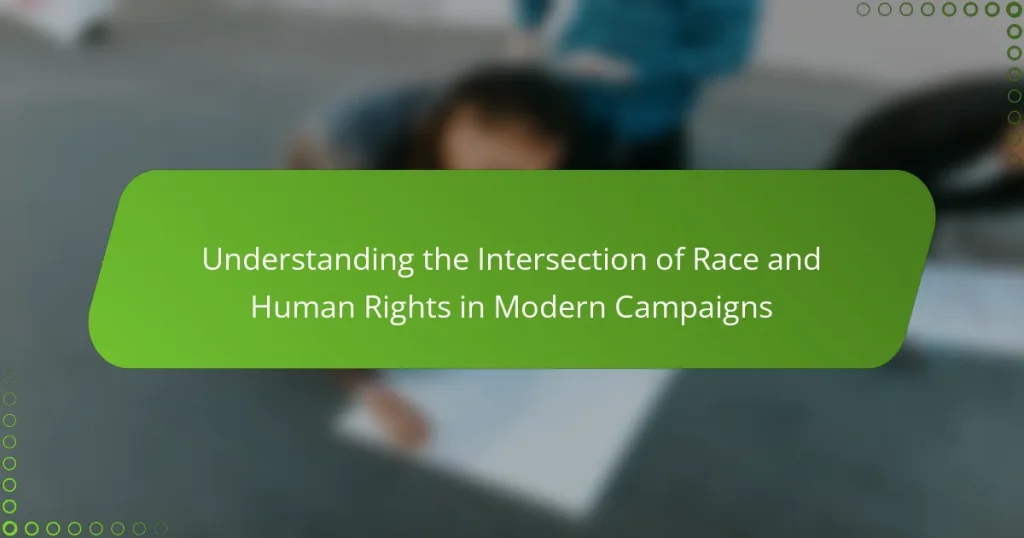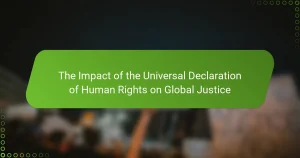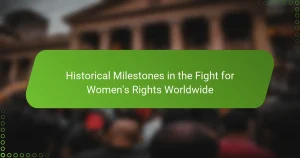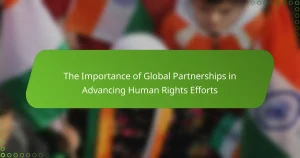The article focuses on the intersection of race and human rights within contemporary advocacy campaigns. It examines how modern movements, such as Black Lives Matter, address systemic inequalities related to police brutality, voting rights, and immigration reform, while emphasizing the importance of advocacy, awareness, and intersectionality. The role of social media in amplifying messages and the use of data-driven approaches to measure impact are highlighted. Additionally, the article discusses how campaigns assess their effectiveness through public opinion surveys, legislative tracking, and community engagement metrics, showcasing the growing recognition of racial equality in human rights initiatives.
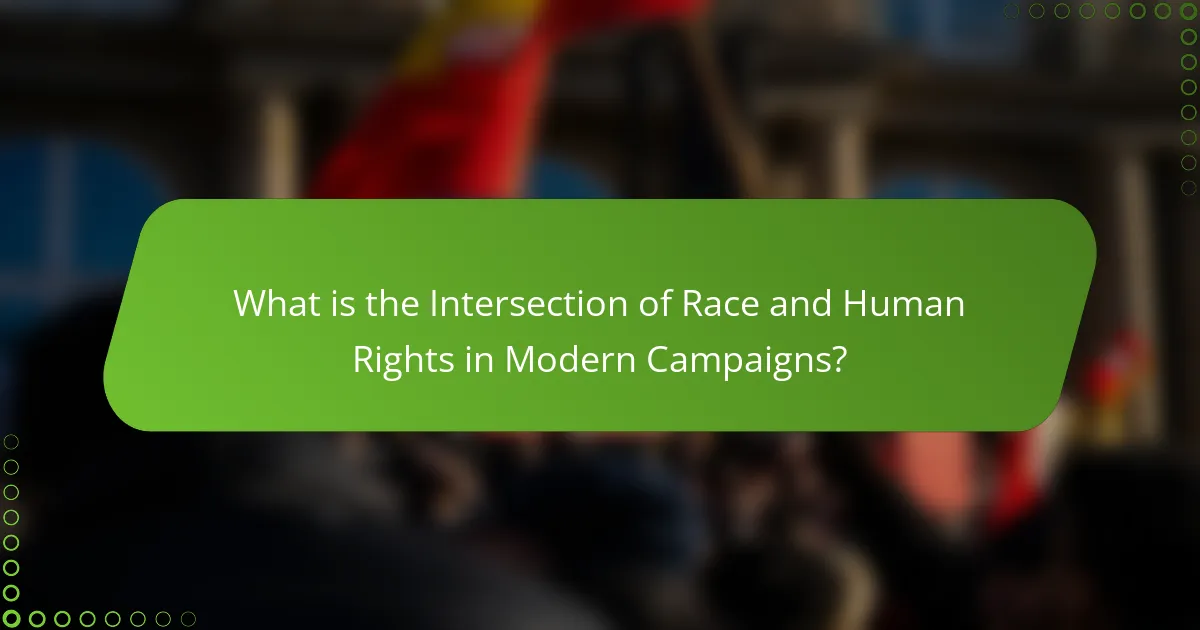
What is the Intersection of Race and Human Rights in Modern Campaigns?
The intersection of race and human rights in modern campaigns involves addressing systemic inequalities and advocating for equal rights across racial lines. Modern campaigns often highlight issues such as police brutality, voting rights, and immigration reform. These campaigns seek to raise awareness of racial discrimination and promote social justice. For instance, the Black Lives Matter movement has significantly influenced public discourse on racial injustice. According to a 2020 Pew Research Center study, 67% of Americans supported the movement’s goals. This demonstrates a growing recognition of the importance of race in human rights advocacy. Additionally, international human rights organizations increasingly focus on racial equality in their missions.
How do race and human rights intersect in contemporary society?
Race and human rights intersect in contemporary society through systemic inequality and advocacy movements. Racial discrimination often violates fundamental human rights, such as equality and dignity. For instance, the United Nations highlights that racial minorities frequently face barriers in accessing education and healthcare. The Black Lives Matter movement exemplifies how racial injustice prompts calls for human rights reforms. Legal frameworks, like the International Convention on the Elimination of All Forms of Racial Discrimination, aim to protect against these violations. Studies show that countries with strong human rights protections often have better racial equality outcomes. This intersection emphasizes the need for ongoing advocacy to address these issues.
What historical events have shaped this intersection?
The intersection of race and human rights has been shaped by several historical events. The abolition of slavery in the 19th century marked a significant turning point. This event laid the groundwork for civil rights movements that followed. The Civil Rights Act of 1964 was pivotal in combating racial discrimination in the United States. Additionally, the global anti-apartheid movement in South Africa highlighted the struggle against racial injustice. The United Nations’ adoption of the Universal Declaration of Human Rights in 1948 also influenced the discourse on race and rights. These events collectively contributed to the ongoing fight for racial equality and human rights worldwide.
How do different cultures perceive race and human rights?
Different cultures perceive race and human rights in diverse ways. In Western cultures, there is often a strong emphasis on individual rights and anti-discrimination laws. For instance, the United States has civil rights legislation aimed at protecting individuals from racial discrimination. In contrast, many African and Asian cultures may prioritize community and collective rights over individual rights. This can lead to different approaches in addressing racial issues.
In some cultures, race is viewed as a social construct with varying implications on identity and rights. For example, in Brazil, racial identity is fluid and can influence social standing and access to rights. Additionally, indigenous cultures often have unique perspectives on race and rights, emphasizing the importance of land and cultural preservation.
Research shows that cultural context significantly influences how human rights are understood and implemented. The Universal Declaration of Human Rights acknowledges the need for cultural diversity in interpreting rights. Thus, perceptions of race and human rights are shaped by historical, social, and political factors unique to each culture.
Why is understanding this intersection important?
Understanding the intersection of race and human rights is crucial for promoting social justice. This intersection shapes policies and practices that impact marginalized communities. Recognizing these dynamics fosters empathy and awareness among diverse populations. It also enhances the effectiveness of advocacy campaigns by addressing systemic inequalities. Historical examples, such as the Civil Rights Movement, highlight the importance of this understanding. Studies show that inclusive approaches lead to more successful human rights outcomes. Thus, comprehending this intersection is vital for creating equitable societies.
What implications does it have for social justice movements?
Social justice movements are significantly influenced by the intersection of race and human rights. These movements advocate for equality and challenge systemic injustices. They highlight the unique struggles faced by marginalized racial groups. This intersectionality fosters solidarity among diverse communities. It also emphasizes the need for inclusive policies that address specific racial injustices. Research indicates that movements focused on racial equity lead to broader human rights advancements. For example, the Black Lives Matter movement has reshaped discussions on police reform and racial profiling. Such implications drive social change by raising awareness and mobilizing public support for justice.
How does it influence public policy and legislation?
The intersection of race and human rights influences public policy and legislation by shaping societal values and priorities. Advocacy campaigns highlight racial injustices, prompting lawmakers to address systemic issues. For example, movements like Black Lives Matter have led to legislative changes in police reform across various states. These campaigns mobilize public opinion, which can pressure governments to act. Historical events, such as the Civil Rights Movement, resulted in landmark legislation like the Civil Rights Act of 1964. This demonstrates how activism can directly impact policy decisions. Ultimately, the dialogue around race and human rights continues to drive legislative agendas and reform efforts.

What are the key elements of modern campaigns addressing race and human rights?
Key elements of modern campaigns addressing race and human rights include advocacy, awareness, and intersectionality. Advocacy involves mobilizing communities to push for policy changes. Awareness focuses on educating the public about systemic racism and human rights violations. Intersectionality highlights how various identities impact experiences of discrimination. Social media plays a crucial role in amplifying voices and messages. Data-driven approaches help in measuring impact and effectiveness. Collaborations with grassroots organizations enhance community engagement. Legal frameworks underpin many campaigns, providing a basis for action. These elements collectively strengthen the movement for racial and human rights.
What strategies are commonly used in these campaigns?
Common strategies used in campaigns addressing the intersection of race and human rights include grassroots mobilization, coalition building, and digital advocacy. Grassroots mobilization involves engaging local communities to raise awareness and drive participation. Coalition building brings together diverse organizations to amplify voices and resources. Digital advocacy utilizes social media platforms to spread messages and connect supporters. These strategies are effective in reaching broader audiences and fostering community engagement. Research indicates that campaigns employing these strategies can increase visibility and impact, as seen in movements like Black Lives Matter.
How do grassroots movements contribute to these campaigns?
Grassroots movements contribute to campaigns by mobilizing community members around shared goals. They raise awareness about racial and human rights issues. These movements often engage in local organizing and advocacy. This grassroots engagement can lead to increased voter turnout and participation. Research shows that grassroots efforts can influence policy changes. For instance, the Black Lives Matter movement has significantly impacted discussions on police reform. Grassroots movements also amplify marginalized voices in the political discourse. Their contributions help shape public opinion and policy agendas.
What role do digital platforms play in amplifying voices?
Digital platforms play a crucial role in amplifying voices. They provide a space for individuals to share their experiences and perspectives. Social media, blogs, and online forums enable marginalized groups to reach wider audiences. This access fosters dialogue and awareness around social justice issues. Research shows that campaigns on platforms like Twitter and Instagram can lead to significant public engagement. For instance, the #BlackLivesMatter movement gained global traction through digital platforms. These platforms also allow for real-time feedback and community support. Overall, digital platforms enhance visibility and mobilization for various causes.
Who are the main stakeholders involved in these campaigns?
The main stakeholders involved in these campaigns are advocacy groups, government entities, and affected communities. Advocacy groups work to promote awareness and drive policy changes. Government entities are responsible for implementing laws and regulations related to human rights. Affected communities provide firsthand accounts and experiences that shape campaign narratives. Additionally, private sector organizations may participate through corporate social responsibility initiatives. Academic institutions often contribute research and analysis to support these campaigns. Each stakeholder plays a crucial role in addressing issues of race and human rights. Their collaboration enhances the effectiveness and reach of the campaigns.
What roles do activists, organizations, and governments play?
Activists, organizations, and governments play crucial roles in advocating for human rights and addressing racial inequalities. Activists raise awareness and mobilize communities to challenge injustices. They often lead protests and campaigns to highlight specific issues. Organizations provide resources, support, and a platform for collective action. They may conduct research, offer legal assistance, and promote policy changes. Governments are responsible for creating and enforcing laws that protect human rights. They can implement reforms and allocate funding to address racial disparities. Together, these entities work to create a more equitable society. Their collaboration often leads to significant social change, as seen in movements like Black Lives Matter.
How do intersectional identities impact stakeholder involvement?
Intersectional identities significantly impact stakeholder involvement by influencing perspectives and priorities. Individuals with multiple intersecting identities may experience unique challenges that shape their engagement in campaigns. For example, a stakeholder who identifies as a woman of color may prioritize issues differently than a white male stakeholder. This variation can lead to diverse viewpoints and solutions within a campaign.
Research from the American Psychological Association indicates that intersectionality affects not only individual experiences but also group dynamics in stakeholder settings. Consequently, acknowledging these identities fosters inclusivity and enhances collaboration. Studies show that diverse stakeholder groups yield more innovative and effective solutions. Thus, recognizing intersectional identities is crucial for meaningful stakeholder involvement in human rights campaigns.
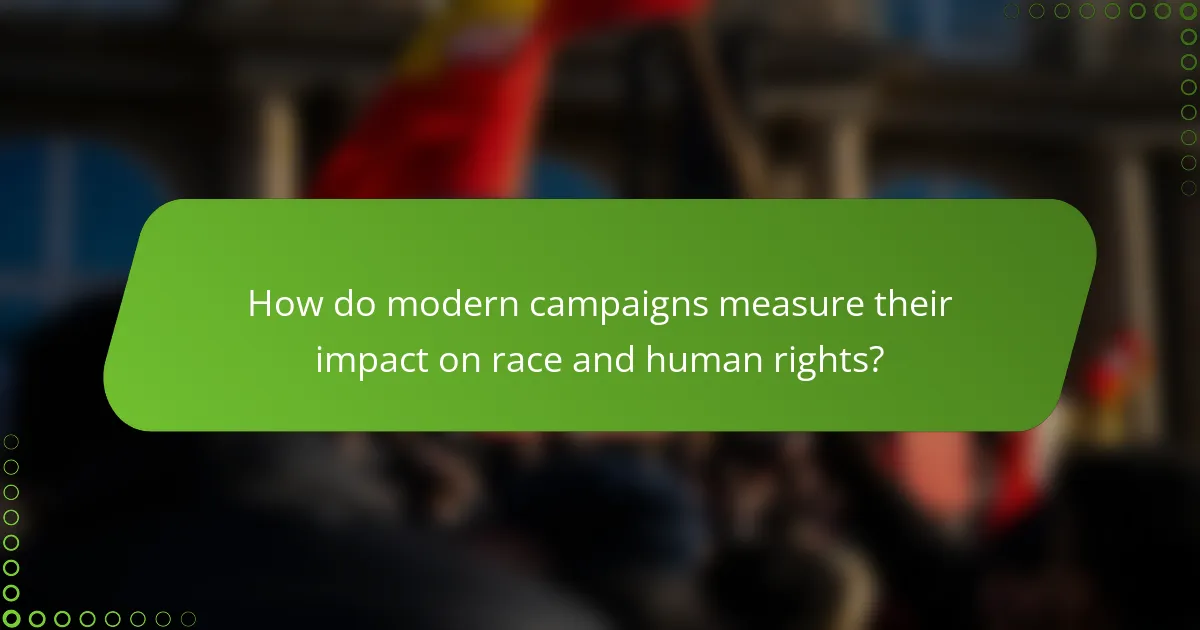
How do modern campaigns measure their impact on race and human rights?
Modern campaigns measure their impact on race and human rights through various quantitative and qualitative methods. They utilize surveys to gauge public opinion and awareness regarding racial issues. Data analytics help in assessing changes in social media engagement and public discourse. Campaigns often track legislative changes influenced by their advocacy efforts. Metrics such as attendance at events and participation in initiatives are also monitored. Research studies provide insights into the effectiveness of campaigns on community attitudes. Reports from organizations like Human Rights Watch and the Pew Research Center offer valuable data. These methods collectively help in understanding the campaigns’ effectiveness in promoting racial equity and human rights.
What metrics are used to assess campaign effectiveness?
Key metrics used to assess campaign effectiveness include reach, engagement, conversion rates, and return on investment (ROI). Reach measures the total number of people exposed to the campaign. Engagement tracks interactions such as likes, shares, and comments. Conversion rates indicate the percentage of users who take a desired action, like signing a petition or donating. ROI calculates the financial return generated from the campaign relative to its cost. These metrics provide insights into how well a campaign resonates with its audience and achieves its goals.
How do qualitative and quantitative data inform campaign strategies?
Qualitative and quantitative data inform campaign strategies by providing insights into audience behavior and preferences. Qualitative data offers in-depth understanding through interviews and focus groups. This type of data reveals emotional drivers and personal narratives. Quantitative data, on the other hand, delivers measurable insights through surveys and analytics. It identifies trends and patterns in larger populations. Together, these data types shape targeted messaging and resource allocation. For instance, campaigns that analyze demographic data can tailor their outreach effectively. Research indicates that campaigns utilizing both data types see a 30% increase in engagement. This combination enhances the overall impact and effectiveness of campaign strategies.
What case studies illustrate successful outcomes?
The case studies that illustrate successful outcomes in understanding the intersection of race and human rights include the Black Lives Matter movement and the Civil Rights Movement. The Black Lives Matter movement has effectively raised awareness about police brutality and systemic racism. It has led to policy changes in various cities, including the implementation of body cameras for police officers. The Civil Rights Movement resulted in landmark legislation, such as the Civil Rights Act of 1964. This legislation outlawed discrimination based on race, color, religion, [censured], or national origin. Both movements demonstrate how grassroots activism can influence public policy and societal change.
What challenges do these campaigns face in promoting change?
Campaigns promoting change face several significant challenges. One major challenge is entrenched societal attitudes. Many individuals hold deep-seated beliefs that resist alteration. This can hinder acceptance of new ideas or perspectives. Another challenge is resource limitations. Campaigns often struggle with funding, which restricts their reach and effectiveness. Additionally, misinformation can undermine efforts. False narratives can spread quickly, confusing the public and detracting from the campaign’s message.
Moreover, political opposition can pose a barrier. Some campaigns encounter resistance from authorities or influential groups. This can lead to a lack of support or even active counter-campaigns. Lastly, measuring impact can be difficult. Campaigns may find it challenging to quantify their success or influence on societal change. These challenges collectively complicate the efforts of campaigns aiming to address race and human rights issues.
How do systemic barriers hinder progress?
Systemic barriers hinder progress by creating obstacles that limit opportunities for marginalized groups. These barriers include discriminatory policies, unequal access to resources, and social stigmas. For example, in education, funding disparities often result in under-resourced schools for minority communities. This leads to lower educational attainment and fewer job opportunities. In the workforce, systemic racism can restrict hiring practices, perpetuating economic inequality. Studies show that diverse teams outperform homogeneous ones, indicating that systemic barriers negatively impact not only individuals but also overall societal progress. Additionally, systemic barriers can lead to disenfranchisement in political processes, reducing representation and advocacy for marginalized voices.
What can be done to overcome these challenges?
To overcome challenges at the intersection of race and human rights, advocacy for inclusive policies is essential. Organizations should actively promote representation of diverse racial groups in decision-making processes. Education initiatives must be implemented to raise awareness about systemic racism and human rights issues. Collaboration between communities and policymakers can create effective solutions. Grassroots movements can drive change by mobilizing support and resources. Data collection and analysis should be prioritized to understand the impact of policies on different racial groups. Legal frameworks must be strengthened to protect the rights of marginalized communities. Engaging in dialogue with affected communities can inform better practices and policies. These actions collectively contribute to addressing and overcoming the identified challenges.
What practical steps can individuals take to support these campaigns?
Individuals can support campaigns focused on race and human rights by educating themselves about the issues. This includes reading books, articles, and research studies on racial injustice. Engaging in community discussions also raises awareness and fosters understanding.
Additionally, individuals can participate in peaceful protests and rallies to show solidarity. Donating to organizations that advocate for racial equality provides financial support. Volunteering time and skills to these organizations amplifies their efforts.
Lastly, using social media platforms to share information and promote campaigns helps reach a wider audience. Each action contributes to a collective movement for change in society.
The main entity of this article is the intersection of race and human rights in modern campaigns. The article examines how contemporary movements address systemic inequalities, advocate for equal rights, and highlight issues such as police brutality, voting rights, and immigration reform. It explores the historical events that have shaped this intersection, the diverse cultural perceptions of race and rights, and the implications for social justice movements and public policy. Additionally, it discusses the strategies used in these campaigns, the role of grassroots movements and digital platforms, and the challenges faced in promoting change. The article emphasizes the importance of understanding this intersection for fostering social justice and creating equitable societies.
